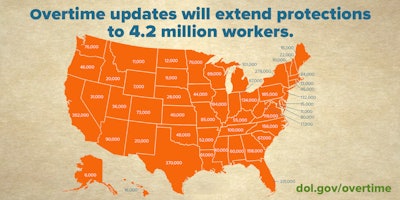 This map shows the Labor Department’s estimate of how many workers in each state are likely to be affected by the new overtime rule, which goes into effect Dec. 1.
This map shows the Labor Department’s estimate of how many workers in each state are likely to be affected by the new overtime rule, which goes into effect Dec. 1.Graphic: U.S. Department of Labor
EDITOR’S NOTE: This column, originally posted on the U.S. Department of Labor website, was written by David Weil, administrator of DOL’s Wage and Hour Division.
Last week we announced the most meaningful update to the nation’s white-collar overtime rules in more than 40 years. By raising the salary threshold under which white-collar salaried workers qualify for overtime pay to $47,476 per year, more than 4.2 million workers will get overtime protections or see a raise in their salary above that threshold.
It’s a fix that will make it easier for employers to determine which of their employees is due overtime pay. For workers affected by the rule, extra work will now mean extra pay. For both, it will create clarity and greater certainty about overtime into the future since the threshold will be updated every three years.
It’s a commonsense policy, but – if you listen to the critics – it’s a catastrophe. The good news is that much of the criticism is based on misconceptions about what the rule does and doesn’t do. Let’s take a look:
Myth: You’re hurting the very people you’re trying to help.
Truth: The people who will benefit from this rule have been working extra hours without seeing a dime of overtime pay. Thanks to the rule, they’ll be paid when they put in more than 40 hours per week, get a bump up to the new salary threshold ($47,476 per year), or get that extra time back − which could go toward family time, the gym, classes or much more.
Myth: Telework and flexible schedules will be eliminated. And everyone will punch a time clock.
Truth: The Fair Labor Standards Act is a nimble law. Employers have flexibility to choose the options that work best for their workplace, including how to keep track of hours. There’s nothing that says workers have to punch time clocks. There’s nothing that says workers have to work specific hours or in specific places.
Myth: Workers will be demoted. Full-time professional careers and incentives will go the way of the dodo.
Truth: There is nothing in the overtime rule that would require an employer to shift an employee from salaried to hourly, or to part time, or to eliminate bonuses which can now be counted towards the salary threshold for the first time. Employers can continue to pay overtime-eligible workers a salary if they choose, and they can continue to provide the same level of responsibilities, benefits, flexibility, training and advancement opportunities as they do now.
Myth: Worker morale will hit an all-time low.
Truth: You know what’s bad for morale? Working 50, 60 or even 70 hours a week without additional pay. This rule will fix that, and the extra pay will help workers pay their bills, or even take a vacation.
Myth: The new rule will just cause more litigation.
Truth: Because the salary threshold has eroded so far over time, people who currently are entitled to overtime protection often don’t receive it. By raising the threshold and creating a brighter line for overtime eligibility, the new rule will protect the almost three-quarters of a million overtime-eligible workers who we estimate do not get overtime pay when they work more than 40 hours a week. That brighter line means more protection and less need for costly litigation to receive it. Increased clarity is good for workers – and for employers who want to comply with the law.
Myth: This rule was rushed, the department didn’t listen to the comments, and now employers have little time to get ready for the new requirements.
Truth: We’ve been working on this update since President Obama’s March 2014 directive. We spent more than a year meeting with stakeholders before issuing the proposed rule in July 2015. And then we reviewed more than 270,000 comments received during the 60-day comment period. These comments led to significant changes in the final rule, such as a lower salary threshold than proposed and a delayed effective date. Employers have more than six months to get ready for the rule to become effective. That’s two months longer than employers were given in 2004 when the rule was last changed.
Here’s the basic truth about the overtime rule: It’s about more money in the pockets of some workers who work long hours or more time for some to spend with their families. And it’s about greater clarity and flexibility for employers and workers alike.











